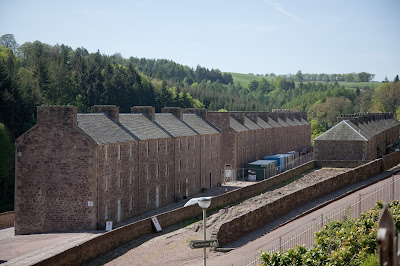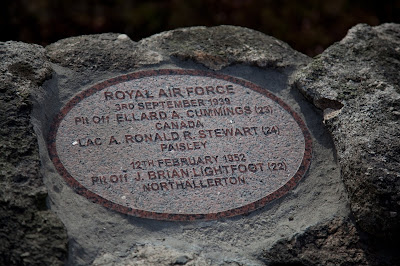New Lanark – A Mexican Menie - By Duncan Harley
New Lanark is best known as the site of a social experiment set up by Robert Owen.
Owen, a mill-owner come social reformer, had seen first hand the results of the abuse of the labour force in the early stages of the Industrial Revolution and formed the opinion that better conditions would improve production as well as improving the lives of the workers in the cotton mills.
Robert Owen's big view was that a “permanent cause of distress
was to be found in the competition of human labour with machinery and that the
only effective remedy was the united action of men and the subordination of
machinery.”
Between 1799 and 1813 he improved the lot of the workforce
at New Lanark. He introduced educational provision for both children (who
formed a significant portion of the workforce) and adults and improved housing
and access to basic foodstuffs by pioneering the Cooperative Movement. Street
lighting was provided as was free access to medical treatment and state of the
art sanitation and water supplies.
The village became a model for social reformers both in the
UK and across Europe. By the 1960’s however it was under threat from general neglect
and the mills finally closed in 1968.
The Lanarkshire County Council of the time seemed largely
uninterested and it was only through the work of the New Lanark Association
that the buildings and heritage survived. Houses were renovated and over time
the village gained a new status as both a living museum to social reform and a
historic place in which to live and enjoy the beauty of the surroundings.
This is a council with a long history of what some term unusual
decision making.
In the 1970’s for example, the Hamilton Palace Grounds were sold off to developers and now sport a retail park. This despite the land having been left “in perpetuity” to the people of Hamilton by the Duke of Hamilton’s estate.
And, in the 1980’s the council approved the plan to create Strathclyde Park which neatly packaged the flooding of the local marshland habitat of Bothwell Haugh to create a weed infested nitrate rich waterway with a US style fast food fun park. Locally known as Junkie World, most residents avoid the place in summer evenings due to the risk of mugging or worse.
In the 1970’s for example, the Hamilton Palace Grounds were sold off to developers and now sport a retail park. This despite the land having been left “in perpetuity” to the people of Hamilton by the Duke of Hamilton’s estate.
And, in the 1980’s the council approved the plan to create Strathclyde Park which neatly packaged the flooding of the local marshland habitat of Bothwell Haugh to create a weed infested nitrate rich waterway with a US style fast food fun park. Locally known as Junkie World, most residents avoid the place in summer evenings due to the risk of mugging or worse.
Then along came industrialists who promised jobs and wealth
from open cast mining. The Clyde Valley is now scarred by open cast coal and
sand workings. The idea of course is to strip back the topsoil for
re-instatement when extraction is complete.
However, the nature of the process means that woodland, grassland, dykes, copses and hedges are destroyed and wildlife habitat at best interrupted and at worst completely annihilated. The Cemex proposals were perhaps just one of many steps too far and when the Mexican conglomerate filed an application to expand an existing opencast quarrying operation just upstream from New Lanark village at the Falls of Clyde local opposition became fierce.
However, the nature of the process means that woodland, grassland, dykes, copses and hedges are destroyed and wildlife habitat at best interrupted and at worst completely annihilated. The Cemex proposals were perhaps just one of many steps too far and when the Mexican conglomerate filed an application to expand an existing opencast quarrying operation just upstream from New Lanark village at the Falls of Clyde local opposition became fierce.
The river-falls which powered the Owen mills form a rich
habitat as well as an providing an iconic beauty spot. Generations of Hamiltonians and a good few campaign groups protested that the proposed
new opencast workings would be visible from the New Lanark valley and that the
noise of the extraction machinery would invade the tranquillity of the heritage
village.
Oddly perhaps, Cemex were of the opinion that the 3.6
million tons of sand and gravel it planned to extract would have no visual
impact. Campaigners completely disagreed. Many also feared that the potential
loss of UNESCO status would further damage the site since the initial six-year-expansion
application would likely lead to further applications down the line. Additionally,
it turned out that the quarry expansion was likely to lead to just the one
additional job.
Scotland has a very few UNESCO listed World Heritage
Sites. In no particular order of importance, they include St Kilda, New Lanark,
Edinburgh Old and New Town and Skara Brae in Orkney.
For the time being at least, and after seven years of wrangling, New Lanark seems safe from invasion via foreign capital and that’s without a billion-dollar bill for a border wall.
For the time being at least, and after seven years of wrangling, New Lanark seems safe from invasion via foreign capital and that’s without a billion-dollar bill for a border wall.
Dorothy Wordsworth visited in some long forgotten year or other.
Never short of a bon mot, she describes the New Lanark Falls thus: ‘After having stayed some time, we returned by the same footpath into the main carriage-road, and soon came upon what William calls an ell-wide gravel walk, from which we had different views of the Linn. We sat upon a bench, placed for the sake of one of these views, whence we looked down upon the waterfall, and over the open country, and saw a ruined tower, called Wallace's Tower, which stands at a very little distance from the fall, and is an interesting object.'
Both Dorothy and her partner William might well have been pleasantly pleased at today's planning decision.
Duncan Harley is author of The
A-Z of Curious Aberdeenshire plus the forthcoming title: The Little History of Aberdeenshire- due out in March 2019Never short of a bon mot, she describes the New Lanark Falls thus: ‘After having stayed some time, we returned by the same footpath into the main carriage-road, and soon came upon what William calls an ell-wide gravel walk, from which we had different views of the Linn. We sat upon a bench, placed for the sake of one of these views, whence we looked down upon the waterfall, and over the open country, and saw a ruined tower, called Wallace's Tower, which stands at a very little distance from the fall, and is an interesting object.'
Both Dorothy and her partner William might well have been pleasantly pleased at today's planning decision.












Comments
Post a Comment